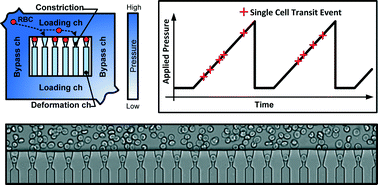Multiplexed fluidic plunger mechanism for the measurement of red blood cell deformability†
Abstract
The extraordinary deformability of red blood cells gives them the ability to repeatedly transit through the microvasculature of the human body. The loss of this capability is part of the pathology of a wide range of diseases including malaria, hemoglobinopathies, and micronutrient deficiencies. We report on a technique for multiplexed measurements of the pressure required to deform individual red blood cell through micrometer-scale constrictions. This measurement is performed by first infusing single red blood cells into a parallel array of ~1.7 μm funnel-shaped constrictions. Next, a saw-tooth pressure waveform is applied across the constrictions to squeeze each cell through its constriction. The threshold deformation pressure is then determined by relating the pressure–time data with the video of the deformation process. Our key innovation is a self-compensating fluidic network that ensures identical pressures are applied to each cell regardless of its position, as well as the presence of cells in neighboring constrictions. These characteristics ensure the consistency of the measurement process and robustness against blockages of the constrictions by rigid cells and debris. We evaluate this technique using in vitro cultures of RBCs infected with P. falciparum, the parasite that causes malaria, to demonstrate the ability to profile the deformability signature of a heterogeneous sample.


 Please wait while we load your content...
Please wait while we load your content...